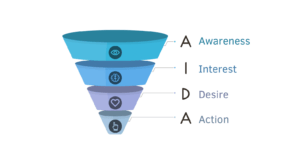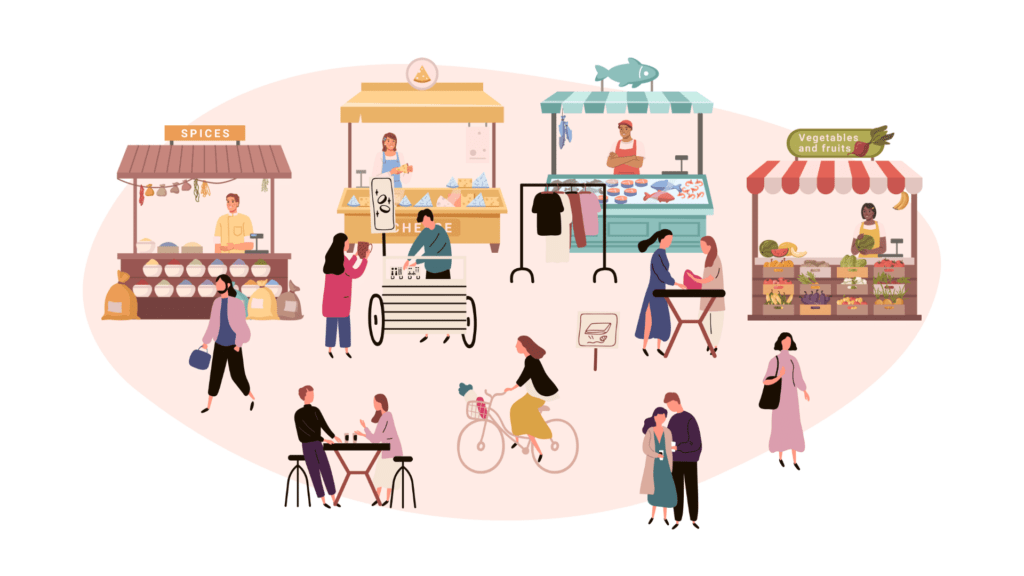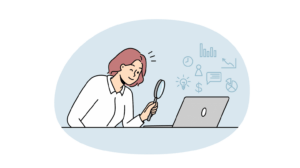Summary – The AIDA (Awareness, Interest, Desire, and Action) Model, a cornerstone in the AIDA marketing approach, is a powerful tool in sales and marketing used for many years as an acquisition funnel. This AIDA framework effectively guides website conversion rates by maximizing each stage. Misalignments in the message throughout the conversion funnel can disconnect user intent, but understanding the AIDA strategy helps align these elements. Today, using the AIDA formula, you will learn how funnel optimization can enhance your website conversion rates. The AIDA acronym is a process that ensures success at every stage, which we will explore in this article.
Did you miss our free webinar “Mastering the Top of the Funnel”?
Watch now on-demand
Funnel Optimization Using the AIDA Model
A surefire way to trace your customers’ journey through every successful purchase is by using the AIDA model. Also known as a sales or acquisition funnel, maximizing each stage is vital for achieving website conversions. We’ll explore each stage to enhance your understanding of the AIDA marketing model, offering insights into successful funnel optimization and its rewards.
The AIDA Model stands for Awareness, Interest, Desire, and Action, often integrating the Awareness and Attention stages. Renowned as a classic in marketing models, the AIDA Model has been instrumental in charting a course toward effective visitor engagement and purchase intent.
Applying the AIDA model requires a holistic view; focusing on a single element can oversimplify the process. Recognizing the interconnection of each stage prevents fragmented customer experiences, and a unified AIDA strategy ensures a fluid, customer-centric journey.

Integrating AIDA into Comprehensive Marketing Strategies
Understanding the AIDA model in marketing is essential, but effectively integrating it into a broader AIDA strategy demands thoughtful application. Customizing approaches to align with your target audience’s unique needs is crucial. For instance, in the Awareness stage, social media campaigns can excel in capturing attention, aligning well with the attention, interest, desire, and action concept. At the same time, email marketing might better nurture interest and desire.
A cohesive marketing effort, harmoniously aligning each stage of AIDA with tailored tactics, is vital. This involves creating engaging content and mastering persuasive techniques within the AIDA framework. A comprehensive strategy that balances all AIDA elements leads to more effective, sustainable marketing outcomes.

The basics and the measurements of each stage of the AIDA model
Awareness
Awareness Stage
The first stage of the funnel is Awareness, wherein you have the most significant number of visitors to work with. During this stage, the visitors already know the solution they’re looking for to satisfy a need. Your job is to familiarize the visitor with the value you have to offer. So, how do you ensure the acquisition funnel is as leak-free as possible?
Rules for the Awareness Stage
- Website browsing shouldn’t be a quest to find hidden CTAs – If a visitor can’t find something on the website quickly enough, it does not exist for that visitor.
- Moderation is critical – If you try to emphasize too many qualities of your business, everything loses importance.
- Delays are a big NO – Any delay in loading pages or returning search results causes frustration and makes the website lose credibility, which Google is now penalizing for in their search results. The following article is an excellent read to understand Funnel Optimization better.
Your guide to Core Web Vitals
Dos and Don’ts of the Awareness Stage
Dos of the Awareness Stage:
- Keep it simple and direct – Stop overwhelming your visitors with too much information that comes too soon.
- Keep the choices to a minimum – You need to help visitors solve a problem, not add to their problem by giving them so many options they need clarification.
- Prioritize and improve your website’s user experience – Ensure that your website leaves no room for confusion.
Don’ts of the Awareness Stage:
- Rotating banner ads – These distract visitors and cause more harm than good. In the critical, initial moments of awareness, distractions must be kept at bay.
- Entry popups – These may ruin the website experience to a great extent. If you must have pop-ups, let them appear when the visitor is about to leave.
- Cluttered homepages – Test, remove, and test again until your pages are only left with clear, uncluttered webpages.
It’s crucial to integrate an understanding of your audience’s journey into the Awareness stage. Knowing their preferences, motivations, and pain points allows for more targeted and effective communication. Tailoring your message to resonate with your audience in this first stage sets the foundation for successful progression through the subsequent stages of the AIDA model. Once you only have standout features, there’s a higher chance for your visitors to move through the next stage of the funnel.

Interest
Interest Stage
The Interest Stage is the perfect chance for you to interact with your potential customers by helping them navigate the website and explore all their options.
Rules for the Interest Stage:
- Understand who the customer is – Help them with role-based navigation at this stage so they will continue forward.
- Understand what the customer is trying to do – Identify their need for specific task completion and help them with task-based navigation to help them get closer to finding the solution they are looking for.
In this stage, engaging your audience with content that sparks their interest and aligns with their expectations is vital. This involves creating and sharing information that answers their immediate questions and piques their curiosity about what you offer. The goal is to transform initial awareness into genuine interest, creating a deeper connection with your brand.

The Interest Stage is the perfect chance for you to interact with your potential customers by helping them navigate the website and explore all their options.
Rules for the Interest Stage:
- Understand who the customer is. Help them with role-based navigation at this stage so they will continue forward.
- Understand what the customer is trying to do. Identify their need for specific task completion and help them with task-based navigation to help them get closer to finding the solution they are looking for.

Anatomy of a Purchase: Mistakes to Avoid
Desire
Desire Stage
The third funnel stage, the Desire Stage, is where visitors have already determined their needs or desires. They’re now almost ready to finalize their purchase. As a marketer, you’ll want to ensure they stay with you until the end of the funnel. For proper funnel optimization, it is crucial to keep customers through the Funnel’s beginning consistently. You may want to change your Funnel optimization process if you don’t get the desired conversions.
To pull this off, remember that visitors in this stage want to compare features, check for reliability, and assess the pricing to ensure they’re making the right purchase.
Activities typical at the Desire Stage are:
- Researching
- Comparing features and pricing
- Getting in-depth, detailed information
- Customization (if applicable)
Rules for the Desire Stage:
- Make the research worthwhile – Always provide them with easy-to-scan, good-quality content. Eliminate frustration by giving them options if they reach a dead end. Don’t let the desire fizzle out.
- Make them feel welcome – Make the visitor feel appreciated for using your website. Ensure they feel safe by giving them plenty of trust cues and being transparent in the information offered.
- Personalize the experience – Let visitors feel in control when browsing or taking any other action on the website. Place helpful guides and customer service options in case they need any assistance.
In the Desire Stage, employing persuasive techniques such as highlighting the unique benefits of your products or services becomes crucial. This can include showcasing customer testimonials, success stories, or comparative advantages over competitors. The aim is to enhance your offerings’ perceived value and desirability, converting interest into a strong desire to purchase.

Action
Action Stage
Here’s the critical, final level – The Action Stage. This is where all your marketing efforts should finally pay off. The customer is ready to complete their purchase! They’ve got the specific product on their mind and where they will buy it. All that’s left to do is enter their payment details.
At this stage, the number one question in the visitor’s mind is, “Why should I buy from your website?” You have a successful sales funnel if you can answer this question to the visitor’s satisfaction.
Rules for the Action Stage
- Don’t distract your customers while completing their purchase – Don’t get in the customer’s way when moving towards conversion. Stand back and let them finish. This is not the time to cross-sell, to ask for feedback, or to have them fill out surveys.
- Make the process as easy and user-friendly as possible – This means no mandatory sign-ups, no complicated check-outs, and do not let them search for what to do next.
- No surprises at the last minute! – Don’t spring hidden costs, shipping charges, or minimum order value requirements on the customer just when they are about to enter their payment information. Instead, ensure the customers have a complete idea of what the purchase will cost them BEFORE proceeding to the payment screen.
In optimizing the Action Stage, it’s beneficial to highlight clear calls to action and reassure the customers with security badges or guarantees. These small touches can significantly increase trust and reduce the perceived risk, encouraging the final step of the purchase.
Remember, at each stage, the number of visitors will be reduced. You can only do a little about that fact. That’s why it’s called a sales funnel, not a sales barrel. The output is going to be less than the input.

The Risks of One-Dimensional Focus
Focusing exclusively on one element of the AIDA model risks an imbalanced marketing strategy. Concentrating on Awareness alone, without fostering Interest and Desire, may spark initial interest but fail in conversion. Similarly, an Action-focused approach without building Awareness and Desire could miss opportunities, leading to a disjointed customer experience.
Maintaining a holistic AIDA approach is critical. Equitable attention to each stage of the AIDA model ensures a more seamless and engaging customer journey. From initial awareness to final action, this approach improves conversion rates and enhances customer loyalty within the AIDA marketing framework.
Conclusion
So, how do you win using the AIDA Model?
- Ensuring a good input – Traffic is still crucial for you to work on many visitors during the funnel. A high number of people at the top of the sales funnel is the key.
- By minimizing losses at each stage – Different traffic with various goals will also require you to use the sales funnels for each. Design your funnels by mapping a visitor’s journey from the first point of contact through the conversion.
Moreover, integrating all four stages – attention, interest, desire, and action – into a cohesive AIDA strategy is essential. This approach avoids the oversimplification of focusing on just one element per marketing tactic and ensures a seamless customer journey, maximizing the overall effectiveness of your marketing efforts. Each stage of the AIDA model requires different approaches to maximize the retention of your visitors fully. Website conversion is a tricky yet highly fulfilling process once you establish the effective strategies we discussed in this article. Remember that Funnel optimization requires attention and testing to remain leak-free over time.
Which part of the AIDA model do you need to work on for your website today?




